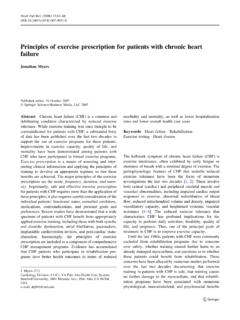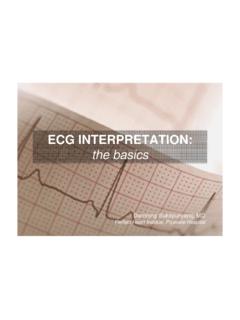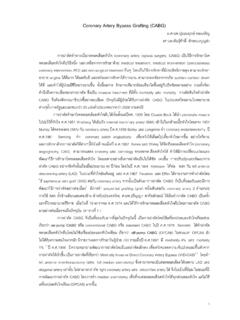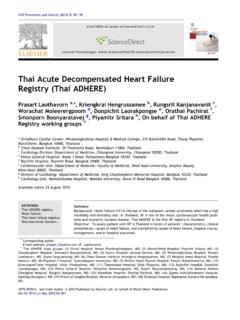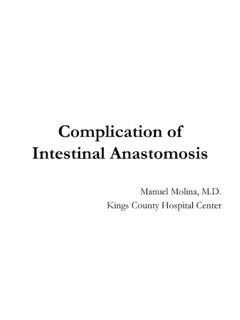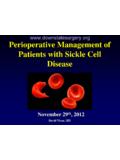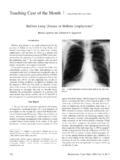Transcription of Cardiac Rehabilitation in Sx Handout - Thai Heart
1 11/4/13 1 Wipawee Laksanakorn, MD Golden Jubilee Medical Center 11/14/2013 Cardiac Rehabilitation in Surgical Condition Golden Jubilee Medical Center Outline Cardiac Rehabilitation 1. Coronary bypass graft(CABG) 2. Valvular Heart disease (VHD) 3. Heart transplantation Recipients (HTRs) 11/4/13 2 Coronary bypass graft (CABG) Coronary bypass graft (CABG) Coronary bypass graft (CABG) 11/4/13 3 Coronary bypass gra, (CABG) Coronary bypass gra, (CABG) Revasculariza;on Goal 1. Improved survival 2. Relieved symptoms Coronary bypass gra, (CABG) Revasculariza;on Goal 1. Improve survival 2. Relieve symptoms 11/4/13 4 Coronary bypass graft (CABG) CABG in Patients With STEMI: Recommendations CLASS I 1. Urgent CABG is indicated in patients with STEMI and coronary anatomy not amenable to PCI who have ongoing or recurrent ischemia, cardiogenic shock, severe HF, or other high-risk features.
2 (Level of Evidence: B) 2. CABG is recommended in patients with STEMI at time of operative repair of mechanical defects. (Level of Evidence: B) CLASS II a 1. The use of mechanical circulatory support is reasonable in patients with STEMI who are hemodynamically unstable and require urgent CABG. (Level of Evidence: C) CLASS II b 1. Emergency CABG within 6 hours of symptom onset may be considered in patients with STEMI who do not have cardiogenic shock and are not candidates for PCI or fibrinolytic therapy. (Level of Evidence: C) 2013 ACCF/AHA Guideline for the Management of ST-Elevation Myocardial Infarction Coronary bypass gra, (CABG) 1. Unprotected Le, main 2. 3 vessel disease with or without proximal LAD artery disease 3. 2 vessel with proximal LAD disease 4. 2 vessel without proximal LAD, with extensive ischemia 5.
3 1 vessel proximal LAD artery with LIMA for long term benefit LV func;on Hillis LD, Smith PK, Anderson JL, Bittl JA, Bridges CR, Byrne JG, et al. 2011 ACCF/AHA guideline for coronary artery bypass graft surgery: executive summary: a report of the American College of Cardiology Foundation/American Heart Association Task Force on Practice Guidelines. The Journal of thoracic and cardiovascular surgery. 2012;143(1):4-34. Coronary bypass gra, (CABG) A 60 year- old, type 2 DM is admitted due to exercise induced angina pectoris. He was history of COPD and still smokes 10 cigarettes/ day. His cholesterol is 270 mg/dL, His BMI is 28 , His blood pressure is 165/95 mmHg and HbA 1 C is % .His currently treated with Metformin and Diltiazem. On admission, troponin remain normal, and a CAG shows a Lt. Main stem stenosis 90%. Echocardiography shows a moderated LV hypertrophy but preserved systolic function. CABG is suggested.
4 11/4/13 5 Coronary bypass gra, (CABG) Problem List?? dz.: DM, COPD factor : Current smoking, Obesity , HT, DM Coronary bypass gra, (CABG) Preoperative - Breathing exercise - Quit smoking - Improved nutrition - Aerobic exercise for improved aerobic capacity and reduce weight (Elective case) - Control blood sugar (Elective case) Coronary bypass gra, (CABG) Breathing exercise Inspiratory Muscle training 11/4/13 6 Coronary bypass gra, (CABG) Cochrane review: Preoperative physical therapy for elective Cardiac surgery patients - 8 Randomized controlled trials with 856 patients used a mixed intervention(Aerobic exercise or breathing exercise) that received preoperative physical therapy had a reduced risk of postoperative atelectasis relative risk (RR) ; CI to :P= and pneumonia RR ; 95% CI to ; P = ) but not of pneumothorax (one study with 45 participants, RR ; 95% CI to ; P = ) or mechanical ventilation for > 48 hours after surgery (two studies with 306 participants, RR ; 95% CI to ; P = ).
5 Postoperative death from all causes did not differ between groups (three studies with 552 participants, RR ; 95% CI to ; P = ) Coronary bypass gra, (CABG) Postoperative 1. Hemodynamic Issue 2. pulmonary Issue 3. Neurological Issue 4. Sternal Wound Margereson, C. and Riley, J. (2008) Post-Operative Care following Cardiothoracic Surgery, in Cardiothoracic Surgical Nursing, Blackwell Science Ltd, Oxford, UK. doi: Coronary bypass gra, (CABG) Hemodynamic Khalpey ZI, Schmitto JD, Rawn JD. Chapter 16. Postoperative Care of Cardiac Surgery Patients. In: Cohn LH, ed. Cardiac Surgery in the Adult. 4th ed. New York: McGraw-Hill; Accessed October 30, 2013. Early Postoperative Hemodynamic Parameters Expected Values Mean arterial pressure (MAP) Systolic blood pressure (SBP) Rt. Arterial pressure (RAP) pulmonary artery wedge pressure(PAWP) 60-90 mmHg 90- 140 mmHg 5-15 mmHg 10-15 mmHg 11/4/13 7 Coronary bypass gra, (CABG) pulmonary Issue - Sternotomy shown to cause an important acute reduction in pulmonary function.
6 - 30 % reduction in vital capacity and expiratory flows at 1St weeks Coronary bypass gra, (CABG) Factors contributing to sternal wound infection /dehiscence Coronary bypass gra, (CABG) Sternal External Fixation - A prospective RCT, 750 male post- standard median sternotomy (78% CABG) . - Used stern- E- Fix corset postoperatively for 6 week with same risk factor of sternal dehiscence - Results: better and effective prevention against development of sternal dehiscence and sternal infection in high risk group 11/4/13 8 Coronary bypass gra, (CABG) Sternal External Fixation - A prospective RCT, 2539 patient post median sternotomy - Used Posthorax corset 24 hr. for at least 6 week - Results: better and effective prevention deep sternal wounds Coronary bypass gra, (CABG) The patient is referred to ambulatory Cardiac Rehabilitation 1 week after discharge from triple vessel bypass operation. He complaint SOB when walking from parking lot to Rehabilitation center No history of orthopnea.
7 Clinical examination shows normal Heart sound, reduced breath sounds over the left lower lung and swelling at Rt. Ankle. Coronary bypass gra, (CABG) Frequency of pulmonary complications after Cardiac surgery complication Frequency,% Pleural effusion Atelectasis Phrenic nerve paralysis Prolonged mechanical ventilation Diaphragmatic dysfunction Pneumonia Diaphragmatic paralysis pulmonary embolism ARDS Aspiration Pneumothorax 27- 95 - 88 30 -75 6 - 58 2 - 54 - 20 9 20 2 11/4/13 9 Coronary bypass gra, (CABG) Leg edema - RCT, 295 post CABG patient (396 limbs )received 2 difference types of compression (both provide 18 mmHg of compression ) medical compression stocking (TED) and elastic bandage-type on donor limbs after CABG - Average 12 day (Admission per) Result: using the kind of knee length compression stocking (TED stocking.) is more effective edema at foot and heel regions in donor limbs after CABG than elastic bandages.
8 Resistance Exercise : Sternal Precaution Exercise program Management of Sternal Precautions Following Median Sternotomy by Physical Therapists in Australia:A Web-Based Survey Exercise program Adams J, Cline MJ, Hubbard M, McCullough T, Hartman J. A new paradigm for post- Cardiac event resistance exercise guidelines. Am J Cardiol. 2006;97:281 286. Forces required to perform ADL 11/4/13 10 Resistance exercise Exercise a,er CABG Aerobic exercise - Moderate intensity - Duration 20-60 min - Frequency 3-5 times/week - Modality: walking, cycling, treadmill, ergometry Swimming = sternal precaution Resistance exercise - 5-8 weeks post operation lifting with UE should restricted to 5-8 pounds. ROM and lifting 1-3 pounds with arms is permissible if no evidence of sternal instability Coronary bypass gra, (CABG) Sexual Issue - Decreased sexual activity among Cardiac patients is frequently reported.
9 - Rates of ED among men with CVD are twice as high as those in the general population, with similar rates of sexual dysfunction in females with CVD. - RCTs using a specific sexual counseling intervention would be useful in determining efficaciousness in reducing the incidence or severity of specific physical and psychological variables. - Independent predictors for preoperative sexual problems in CABG : male gender and DM - Resumed sexual activity in 6 to 8 weeks after a standard CABG surgery (Class II a; Level of Evidence B) or non-coronary open Heart surgery (Class II a ; Level of Evidence C), if the sternotomy is well healed. 11/4/13 11 Valvular Heart Disease(VHD) Valvular Heart Disease(VHD) For supervised Exercise training 1. Medically supervised training in postopera;ve valve surgery 2. Athletes with asymptoma;c VHD 3. Mitral valve prolapse Contraindica;on 1.
10 Truly symptoma;c aor;c stenosis 2. Mitral valve prolapse with syncope 3. High BP (SBP>200 mmHg or diastolic >110 mmHg) 4. Uncontrolled or symptoma;c arrhythmias Valvular Heart Disease(VHD) 11/4/13 12 - Echocardiogram : diagnosing and quan;fying VHD - EKG: Cardiac chamber size - EST: diagnos;c and prognos;c informa;on Valvular Heart Disease(VHD) Value of exercise testing in patients with VHD To assess objective functional capacity To assess atypical symptoms Production of prior unnoticed symptoms To induce pathological hemodynamic response Valvular Heart Disease(VHD) High- Risk exercise Tolerance test Findings in Asymptomatic Severe Aortic Stenosis - Angina or dyspnea - Failure to augment systolic blood pressure > 20 mmHg - > or = 2 mm ST segment depression - Significant ventricular arrhythmia - Mean gradient increase > or = 18 mmHg by Doppler Effect of exercise training - RCT ,64 consecu;ve pt.

